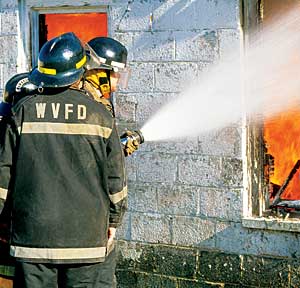Network Cabling Specification and Installation Practices Impact Building Safety
Fire Evidence
The communications cable most often used in commercial buildings is called plenum cabling. It is designed for use specifically in hidden spaces within dropped ceilings that handle return airflow to HVAC equipment-the plenum space-and distributes the network from telecommunications rooms to the users' workstation. Since the 1970s, several significant fires occurred where cable running in plenum spaces greatly increased the severity of the fire damage. A fire that occurred in offices at the World Trade Center in 1975 brought the fire hazards associated with cables installed in plenum spaces to the fore. According to a report by NY Board of Fire Underwriters, "The worst and most hazardous condition is when wires and cables with combustible insulation are run through plenums to service the floor above. This provides a double hazard by introducing combustibles into the air conditioning. It should be noted that the mass of cables to supply communication equipment in many office occupancies is sufficient to sustain a substantial fire. While an individual cable is extremely difficult to ignite, a group of cables lying parallel will burn intensely, similar to the situation that exists with a group of logs in a fireplace."
In May 1988, a fire in the Bell Central Office in Hinsdale, Illinois caused $90 Million in damages and a 17-day outage; calls were disrupted for four weeks. An NFPA fire investigation recounts a chilling scenario: "Fueled by the insulation, the fire quickly spread into the groups of cables in the cable tray and eventually emerged at the top of the cables. The fire was able to travel horizontally both in the confined spaces between cables in the trays and in an open space between the top layer of cables and the ceiling."
 |
| Courtesy of: DuPont Cabling Solutions |
In October 1996 a fire at Rockefeller Center in New York was described in The New York Times: "The fire, reported at 3:59AM, jumped helter-skelter from floor to floor following the snaking utility products, feeding on insulation and thick cable-housing and breaking out into office here and there, fire officials said."
A United States Fire Administration, National Fire Data Center report about a 1991 fire at One Meridian Plaza in Philadelphia found that "Within the telephone and electrical rooms, unprotected penetrations of the floor assemblies allow conduits and exposed wires to travel from floor to floor. Several breaches of fire-resistance rated construction were observed in the walls separating the electrical and telephone rooms from the ceiling plenums and occupied spaces on each floor."
From these and other fires, valuable lessons were learned. Prime among them are the fact that the ignition source is often electrical failure, and cables can add significant fuel load and spread fire rapidly along the cable pathways and spaces. Investigators further concluded that even small fires can cause extensive smoke damage, and combustible materials in concealed spaces are of great concern.
Cabling's Contribution to Fuel Load and Smoke
Electronic communications systems began to be installed on a large scale in the 1970s and 1980s. Seeking ways to cost-effectively run cable through a building, cables were run from floor to floor, through vertical air shafts or other openings. Within a floor, cable was installed above raised ceilings, below raised floors, or within horizontal air ducts, or plenums, obviating the need to break through walls, and enabling cable to be installed out of sight and out of the way. Unfortunately, and not realized at the time, was the fact that these vertical and horizontal runs maximize the spreading of smoke and fire in the building. Smoke and fire quickly rise to higher floors via unobstructed vertical risers. But because these vertical spaces have a higher fire rating and are not part of the building's HVAC system, fire safety requirements for vertical riser cable are less stringent than those for plenum cable. The horizontal plenums, often used to carry forced-air heat and air conditioning, can now carry smoke to all ventilation ducts. The pressurized air flow within a plenum served to force-feed and accelerate the fire with oxygen.
Compounding matters further, over the past two decades, the amount of electronics in a typical office building, hospital, school, or data center has increased dramatically. As a result, there has been a surge in the cabling that connects these systems. In fact, an estimated 60 billion cable feet of local area network cables has been installed in horizontal concealed spaces during the last 20 years in the United States alone. Granted wireless communications and networks are on the rise. Even so, physical cabling still represents the linchpin of a communications or computer network-wireless included. Stoked by ever increasing needs for IT systems, the use of cabling can only continue to soar.









